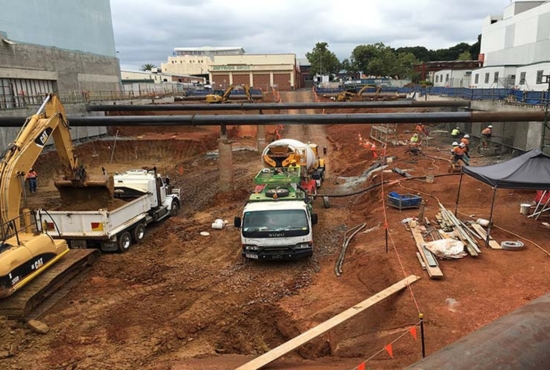


Geotechnical drilling, also known as ‘boring’, can help engineering teams identify any potential hazards that may be encountered during the construction of a proposed structure. The findings that are determined during the drilling are recorded in a geotechnical bore log. The information recorded generally includes things like project details, soil conditions, sample sizes, retrieval methods, type of drill rig used, water and moisture content, boring depth, sample location and more.
The geotechnical bore log is a pivotal record of information for construction planning. Engineering teams will use these findings to evaluate things like project feasibility, environmental impacts, equipment needed for the construction, budget estimates and construction timelines.
The primary purpose of geotechnical drilling is to help inform a geotechnical investigation, which ultimately determines whether the proposed site is going to be suitable for construction. Geotechnical investigations are a crucial component of the construction process because they identify any potential concerns that may impact the feasibility, design & constructability of the proposed structure.
It’s imperative that the geotechnical team carry out the drilling with care and precision because the information garnered will eventually be used to prepare a geotechnical report – an important document that informs the rest of the design and engineering of the proposed structure.
The Geotechnical drilling process is carried out using specialised machinery called drill rigs. Drill rigs are machines that are used to drill holes in the ground and which facilitate soil sampling and soil testing, by retrieving disturbed and undisturbed samples along with core samples of any competent rock encountered. Core samples are long tubular extractions of rock material representative of the condition of the geology below the proposed site. The holes that are bored can range from just below the surface to hundreds of metres deep depending on the project and the engineer’s requirements. These extracted soil and rock core samples are then sent back to our NATA-endorsed laboratory here in Toowoomba to be analysed. Mobile geotechnical drilling rigs can be mounted on trucks, on steel or rubber tracks or even on trailers. At RMA Soils + Geotechnical, our fleet of mobile drill rigs, or vehicle-mounted augers, enable us to provide comprehensive geotechnical drilling services to our clients across Queensland and northern New South Wales.
Geotechnical drilling is carried out by geotechnical drillers who are qualified to operate specialised drilling equipment. This process is generally overseen by a certified geotechnical engineer to ensure that the drilling meets the requirements of the project. Employing a team that possesses all the necessary qualifications and has demonstrated experience delivering accurate and reliable results is essential to ensuring your drilling is carried out safely and the recommendations provided are reliable.
Since geotechnical investigations are critical to the final outcome of the project, all work must be conducted in accordance with relevant industry standards.
In Australia, the regulatory standard that we adhere to is AS1726, which covers the mandated requirements to perform an effective geotechnical site investigation, and provides an industry-wide benchmark for the description and classification of subsurface material.
Geotechnical drilling is typically performed during the pre-construction process. It is an essential part of forming the geotechnical investigation, which is used to determine how a construction project should proceed.
Since unstable foundation conditions can pose safety hazards for people who will interact with the proposed structure, relevant regulatory bodies mandate that geotechnical investigations are carried out before construction permits can be granted.
While it’s not logistically possible to fully analyse the entirety of a site, a qualified geotechnical engineering team will be able to effectively determine an adequate number, location and depth of boreholes required to retrieve enough data to be representative of the area of the site that will be affected by the load of the proposed structure. This determination is based on a number of things such as the type of proposed structure, regulatory standards, geological characteristics of the proposed foundation, and equipment and testing capabilities.
Interested in a career in drilling? RMA Soils + Geotechnical is always on the hunt for future industry leaders and we encourage you to reach out if you have any questions about pursuing a career in this rich and rewarding field.
Drillers typically oversee the drilling process in collaboration with a geotechnical engineer. Their responsibilities often include coordinating the movement, installation, maintenance and operation of drilling rigs, ensuring the safe operation of specialised machinery and preparing sites for drilling operations.
Our team proudly offers geotechnical drilling services for a range of different projects, from land development through to commercial projects, agriculture and more. Our mobile fleet of vehicle-mounted drill rigs means we are able to provide agile and flexible support to clients across the Darling Downs region and beyond.
To get in touch with us about your upcoming project, reach out at enquiries@rmasoils.com.au.
To learn more about the services we offer, head to www.rmasoils.com.au/services.
